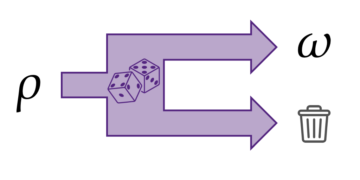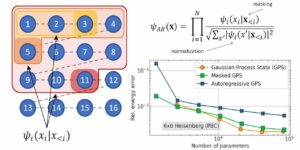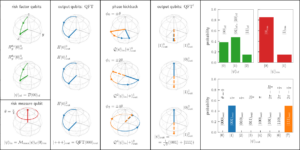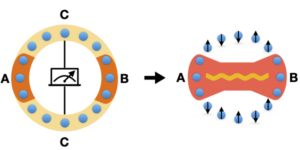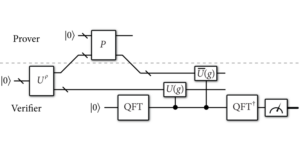1National Research University Higher School of Economics, 109028 Moscow, Russia
2Institute for Spectroscopy, Russian Academy of Sciences, 142190 Troitsk, Moscow, Russia
Find this paper interesting or want to discuss? Scite or leave a comment on SciRate.
Abstract
The Andreev-Bashkin effect, or superfluid drag, is predicted in a system of Bose-condensed excitonic polaritons in optical microcavity coupled by electron-exciton interaction with a superconducting layer. Two possible setups with spatially indirect dipole excitons or direct excitons are considered. The drag density characterizing a magnitude of this effect is found by many-body calculations with taking into account dynamical screening of electron-exciton interaction. For the superconducting electronic layer, we assume the recently proposed polaritonic mechanism of Cooper pairing, although the preexisting thin-film superconductor should also demonstrate the effect. According to our calculations, the drag density can reach considerable values in realistic conditions, with excitonic and electronic layers made from GaAs-based quantum wells or two-dimensional transition metal dichalcogenides. The predicted nondissipative drag could be strong enough to be observable as induction of a supercurrent in the electronic layer by a flow of polariton Bose condensate.
► BibTeX data
► References
[1] A. G. Rojo. “Electron-drag effects in coupled electron systems”. J. Phys.: Condens. Matter 11, R31–R52 (1999).
https://doi.org/10.1088/0953-8984/11/5/004
[2] B. N. Narozhny and A. Levchenko. “Coulomb drag”. Rev. Mod. Phys. 88, 025003 (2016).
https://doi.org/10.1103/RevModPhys.88.025003
[3] C. P. Morath, J. A. Seamons, J. L. Reno, and M. P. Lilly. “Density imbalance effect on the Coulomb drag upturn in an undoped electron-hole bilayer”. Phys. Rev. B 79, 041305 (2009).
https://doi.org/10.1103/PhysRevB.79.041305
[4] A. F. Croxall, K. D. Gupta, C. A. Nicoll, M. Thangaraj, H. E. Beere, I. Farrer, D. A. Ritchie, and M. Pepper. “Anomalous Coulomb drag in electron-hole bilayers”. Phys. Rev. Lett. 101, 246801 (2008).
https://doi.org/10.1103/PhysRevLett.101.246801
[5] J. I. A. Li, T. Taniguchi, K. Watanabe, J. Hone, and C. R. Dean. “Excitonic superfluid phase in double bilayer graphene”. Nat. Phys. 13, 751–755 (2017).
https://doi.org/10.1038/nphys4140
[6] Y. E. Lozovik and V. I. Yudson. “New mechanism for superconductivity: pairing between spatially separated electrons and holes”. Sov. Phys. JETP 44, 389 (1976). url: http://jetp.ras.ru/44/2/p389.
http://jetp.ras.ru/cgi-bin/e/index/e/44/2/p389?a=list
[7] D. K. Efimkin and V. Galitski. “Anomalous Coulomb drag in electron-hole bilayers due to the formation of excitons”. Phys. Rev. Lett. 116, 046801 (2016).
https://doi.org/10.1103/PhysRevLett.116.046801
[8] N. Giordano and J. D. Monnier. “Cross-talk effects in superconductor–insulator–normal-metal trilayers”. Phys. Rev. B 50, 9363–9368 (1994).
https://doi.org/10.1103/PhysRevB.50.9363
[9] X. Huang, G. Bazàn, and G. H. Bernstein. “Observation of supercurrent drag between normal metal and superconducting films”. Phys. Rev. Lett. 74, 4051–4054 (1995).
https://doi.org/10.1103/PhysRevLett.74.4051
[10] R. Tao, L. Li, H.-Y. Xie, X. Fan, L. Guo, L. Zhu, Y. Yan, Z. Zhang, and C. Zeng. “Josephson-Coulomb drag effect between graphene and LaAlO$_{3}$/SrTiO$_{3}$ interfacial superconductor” (2020). arXiv:2003.12826.
arXiv:2003.12826
[11] A. F. Andreev and E. P. Bashkin. “Three-velocity hydrodynamics of superfluid solutions”. Sov. Phys. JETP 42, 164–167 (1975). url: http://jetp.ras.ru/42/1/p164.
http://jetp.ras.ru/cgi-bin/e/index/e/42/1/p164?a=list
[12] J.-M. Duan and S. Yip. “Supercurrent drag via the Coulomb interaction”. Phys. Rev. Lett. 70, 3647–3650 (1993).
https://doi.org/10.1103/PhysRevLett.70.3647
[13] K. Hossain, S. Gupta, and M. M. Forbes. “Detecting entrainment in Fermi-Bose mixtures”. Phys. Rev. A 105, 063315 (2022).
https://doi.org/10.1103/physreva.105.063315
[14] D. V. Fil and S. I. Shevchenko. “Nondissipative drag of superflow in a two-component Bose gas”. Phys. Rev. A 72, 013616 (2005).
https://doi.org/10.1103/PhysRevA.72.013616
[15] D. Romito, C. Lobo, and A. Recati. “Linear response study of collisionless spin drag”. Phys. Rev. Research. 3, 023196 (2021).
https://doi.org/10.1103/PhysRevResearch.3.023196
[16] M. Ota and S. Giorgini. “Thermodynamics of dilute Bose gases: Beyond mean-field theory for binary mixtures of Bose-Einstein condensates”. Phys. Rev. A 102, 063303 (2020).
https://doi.org/10.1103/PhysRevA.102.063303
[17] S. H. Abedinpour and B. Tanatar. “Counterflow in Bose gas bilayers: Collective modes and dissipationless drag”. Low Temp. Phys. 46, 480–484 (2020).
https://doi.org/10.1063/10.0001051
[18] K. Sellin and E. Babaev. “Superfluid drag in the two-component Bose-Hubbard model”. Phys. Rev. B 97, 094517 (2018).
https://doi.org/10.1103/PhysRevB.97.094517
[19] S. Hartman, E. Erlandsen, and A. Sudbø. “Superfluid drag in multicomponent Bose-Einstein condensates on a square optical lattice”. Phys. Rev. B 98, 024512 (2018).
https://doi.org/10.1103/PhysRevB.98.024512
[20] J. Nespolo, G. E. Astrakharchik, and A. Recati. “Andreev-Bashkin effect in superfluid cold gases mixtures”. New J. Phys. 19, 125005 (2017).
https://doi.org/10.1088/1367-2630/aa93a0
[21] V. Karle, N. Defenu, and T. Enss. “Coupled superfluidity of binary Bose mixtures in two dimensions”. Phys. Rev. A 99, 063627 (2019).
https://doi.org/10.1103/PhysRevA.99.063627
[22] M. A. Alpar, S. A. Langer, and J. A. Sauls. “Rapid postglitch spin-up of the superfluid core in pulsars”. Astrophys. J. 282, 533 (1984).
https://doi.org/10.1086/162232
[23] E. Babaev. “Andreev-Bashkin effect and knot solitons in an interacting mixture of a charged and a neutral superfluid with possible relevance for neutron stars”. Phys. Rev. D 70, 043001 (2004).
https://doi.org/10.1103/PhysRevD.70.043001
[24] M. V. Demin, Y. E. Lozovik, and V. A. Sharapov. “Bose condensate drag in a system of two coupled traps”. JETP Lett. 76, 135–138 (2002).
https://doi.org/10.1134/1.1514754
[25] K. S. Novoselov, A. Mishchenko, A. Carvalho, and A. H. Castro Neto. “2D materials and van der Waals heterostructures”. Science 353, 461–472 (2016).
https://doi.org/10.1126/science.aac9439
[26] T. Vincent, J. Liang, S. Singh, E. G. Castanon, X. Zhang, A. McCreary, D. Jariwala, O. Kazakova, and Z. Y. A. Balushi. “Opportunities in electrically tunable 2D materials beyond graphene: Recent progress and future outlook”. Appl. Phys. Rev. 8, 041320 (2021).
https://doi.org/10.1063/5.0051394
[27] Y. E. Lozovik and M. V. Nikitkov. “Drag effects in a two-layer system of spatially separated electrons and excitons”. Sov. Phys. JETP 84, 612–618 (1997).
https://doi.org/10.1134/1.558182
[28] Y. E. Lozovik and M. V. Nikitkov. “Kinetic properties of a system of spatially separated excitons and electrons in the presence of a Bose condensate of excitons”. Sov. Phys. JETP 89, 775–780 (1999).
https://doi.org/10.1134/1.559040
[29] M. V. Boev, V. M. Kovalev, and I. G. Savenko. “Coulomb drag of excitons in Bose-Fermi systems”. Phys. Rev. B 99, 155409 (2019).
https://doi.org/10.1103/PhysRevB.99.155409
[30] O. L. Berman, R. Y. Kezerashvili, and Y. E. Lozovik. “Drag effects in a system of electrons and microcavity polaritons”. Phys. Rev. B 82, 125307 (2010).
https://doi.org/10.1103/PhysRevB.82.125307
[31] O. Cotleţ, F. Pientka, R. Schmidt, G. Zarand, E. Demler, and A. Imamoǧlu. “Transport of neutral optical excitations using electric fields”. Phys. Rev. X 9, 041019 (2019).
https://doi.org/10.1103/PhysRevX.9.041019
[32] I. Carusotto and C. Ciuti. “Quantum fluids of light”. Rev. Mod. Phys. 85, 299–366 (2013).
https://doi.org/10.1103/RevModPhys.85.299
[33] D. M. Myers, Q. Yao, S. Mukherjee, B. Ozden, J. Beaumariage, and D. W. Snoke. “Pushing photons with electrons: Observation of the polariton drag effect” (2021). arXiv:1808.07866.
arXiv:1808.07866
[34] S. Mukherjee, A. S. Bradley, and D. W. Snoke. “Steady-state theory of electron drag on polariton condensates” (2022). arXiv:2202.13175.
arXiv:2202.13175
[35] F. P. Laussy, A. V. Kavokin, and I. A. Shelykh. “Exciton-polariton mediated superconductivity”. Phys. Rev. Lett. 104, 106402 (2010).
https://doi.org/10.1103/PhysRevLett.104.106402
[36] F. P. Laussy. “Superconductivity with excitons and polaritons: review and extension”. J. Nanophoton. 6, 064502 (2012).
https://doi.org/10.1117/1.JNP.6.064502
[37] O. Cotleţ, S. Zeytinoǧlu, M. Sigrist, E. Demler, and A. Imamoǧlu. “Superconductivity and other collective phenomena in a hybrid Bose-Fermi mixture formed by a polariton condensate and an electron system in two dimensions”. Phys. Rev. B 93, 054510 (2016).
https://doi.org/10.1103/PhysRevB.93.054510
[38] P. Skopelitis, E. D. Cherotchenko, A. V. Kavokin, and A. Posazhennikova. “Interplay of phonon and exciton-mediated superconductivity in hybrid semiconductor-superconductor structures”. Phys. Rev. Lett. 120, 107001 (2018).
https://doi.org/10.1103/PhysRevLett.120.107001
[39] E. D. Cherotchenko, T. Espinosa-Ortega, A. V. Nalitov, I. A. Shelykh, and A. V. Kavokin. “Superconductivity in semiconductor structures: The excitonic mechanism”. Superlattices Microstruct. 90, 170–175 (2016).
https://doi.org/10.1016/j.spmi.2015.12.003
[40] E. Sedov, I. Sedova, S. Arakelian, G. Eramo, and A. V. Kavokin. “Hybrid optical fiber for light-induced superconductivity” (2019). arXiv:1912.07212.
arXiv:1912.07212
[41] M. Sun, A. V. Parafilo, K. H. A. Villegas, V. M. Kovalev, and I. G. Savenko. “Theory of BCS-like bogolon-mediated superconductivity in transition metal dichalcogenides”. New J. Phys. 23, 023023 (2021).
https://doi.org/10.1088/1367-2630/abe285
[42] M. Sun, A. V. Parafilo, K. H. A. Villegas, V. M. Kovalev, and I. G. Savenko. “Bose-Einstein condensate-mediated superconductivity in graphene”. 2D Mater. 8, 031004 (2021).
https://doi.org/10.1088/2053-1583/ac0b49
[43] M. Sun, A. V. Parafilo, V. M. Kovalev, and I. G. Savenko. “Strong-coupling theory of condensate-mediated superconductivity in two-dimensional materials”. Phys. Rev. Research 3, 033166 (2021).
https://doi.org/10.1103/PhysRevResearch.3.033166
[44] C. Anton-Solanas, M. Waldherr, M. Klaas, H. Suchomel, T. H. Harder, H. Cai, E. Sedov, S. Klembt, A. V. Kavokin, S. Tongay, K. Watanabe, T. Taniguchi, S. Höfling, and C. Schneider. “Bosonic condensation of exciton–polaritons in an atomically thin crystal”. Nat. Mater. 20, 1233–1239 (2021).
https://doi.org/10.1038/s41563-021-01000-8
[45] D. W. Snoke. “Coherence and optical emission from bilayer exciton condensates”. Adv. Cond. Matter. Phys. 2011, 1–7 (2011).
https://doi.org/10.1155/2011/938609
[46] E. V. Calman, M. M. Fogler, L. V. Butov, S. Hu, A. Mishchenko, and A. K. Geim. “Indirect excitons in van der Waals heterostructures at room temperature”. Nat. Commun. 9, 1895 (2018).
https://doi.org/10.1038/s41467-018-04293-7
[47] B. Datta, M. Khatoniar, P. Deshmukh, R. Bushati, S. De Liberato, S. Kéna-Cohen, and V. M. Menon. “Highly non-linear interlayer exciton-polaritons in bilayer MoS$_2$” (2021). arXiv:2110.13326.
arXiv:2110.13326
[48] L. V. Butov, A. Imamoǧlu, A. V. Mintsev, K. L. Campman, and A. C. Gossard. “Photoluminescence kinetics of indirect excitons in GaAs/Al$_{x}$Ga$_{1-x}$As coupled quantum wells”. Phys. Rev. B 59, 1625–1628 (1999).
https://doi.org/10.1103/PhysRevB.59.1625
[49] E. Togan, H.-T. Lim, S. Faelt, W. Wegscheider, and A. Imamoǧlu. “Enhanced interactions between dipolar polaritons”. Phys. Rev. Lett. 121, 227402 (2018).
https://doi.org/10.1103/PhysRevLett.121.227402
[50] D. A. B. Miller, D. S. Chemla, T. C. Damen, A. C. Gossard, W. Wiegmann, T. H. Wood, and C. A. Burrus. “Electric field dependence of optical absorption near the band gap of quantum-well structures”. Phys. Rev. B 32, 1043–1060 (1985).
https://doi.org/10.1103/PhysRevB.32.1043
[51] H.-J. Polland, L. Schultheis, J. Kuhl, E. O. Göbel, and C. W. Tu. “Lifetime enhancement of two-dimensional excitons by the quantum-confined Stark effect”. Phys. Rev. Lett. 55, 2610–2613 (1985).
https://doi.org/10.1103/PhysRevLett.55.2610
[52] J. Kasprzak, M. Richard, S. Kundermann, A. Baas, P. Jeambrun, J. M. J. Keeling, F. M. Marchetti, M. H. Szymańska, R. André, J. L. Staehli, V. Savona, P. B. Littlewood, B. Deveaud, and Le Si Dang. “Bose-Einstein condensation of exciton polaritons”. Nature 443, 409–414 (2006).
https://doi.org/10.1038/nature05131
[53] J. Zhao, R. Su, A. Fieramosca, W. Zhao, W. Du, X. Liu, C. Diederichs, D. Sanvitto, T. C. H. Liew, and Q. Xiong. “Ultralow threshold polariton condensate in a monolayer semiconductor microcavity at room temperature”. Nano Lett. 21, 3331–3339 (2021).
https://doi.org/10.1021/acs.nanolett.1c01162
[54] T. Byrnes, G. V. Kolmakov, R. Y. Kezerashvili, and Y. Yamamoto. “Effective interaction and condensation of dipolaritons in coupled quantum wells”. Phys. Rev. B 90, 125314 (2014).
https://doi.org/10.1103/PhysRevB.90.125314
[55] M. Wouters and I. Carusotto. “Superfluidity and critical velocities in nonequilibrium Bose-Einstein condensates”. Phys. Rev. Lett. 105, 020602 (2010).
https://doi.org/10.1103/PhysRevLett.105.020602
[56] M. H. Szymańska, J. Keeling, and P. B. Littlewood. “Nonequilibrium quantum condensation in an incoherently pumped dissipative system”. Phys. Rev. Lett. 96, 230602 (2006).
https://doi.org/10.1103/PhysRevLett.96.230602
[57] G. Lerario, A. Fieramosca, F. Barachati, D. Ballarini, K. S. Daskalakis, L. Dominici, M. De Giorgi, S. A. Maier, G. Gigli, S. Kéna-Cohen, and D. Sanvitto. “Room-temperature superfluidity in a polariton condensate”. Nat. Phys. 13, 837–841 (2017).
https://doi.org/10.1038/nphys4147
[58] A. Amo, J. Lefrère, S. Pigeon, C. Adrados, C. Ciuti, I. Carusotto, R. Houdré, E. Giacobino, and A. Bramati. “Superfluidity of polaritons in semiconductor microcavities”. Nat. Phys. 5, 805–810 (2009).
https://doi.org/10.1038/nphys1364
[59] B. Nelsen, G. Liu, M. Steger, D. W. Snoke, R. Balili, K. West, and L. Pfeiffer. “Dissipationless flow and sharp threshold of a polariton condensate with long lifetime”. Phys. Rev. X 3, 041015 (2013).
https://doi.org/10.1103/PhysRevX.3.041015
[60] D. Caputo, D. Ballarini, G. Dagvadorj, C. Sánchez Muñoz, M. De Giorgi, L. Dominici, K. West, L. N. Pfeiffer, G. Gigli, F. P. Laussy, M. H. Szymańska, and D. Sanvitto. “Topological order and thermal equilibrium in polariton condensates”. Nat. Mater. 17, 145–151 (2017).
https://doi.org/10.1038/nmat5039
[61] H. Hu, H. Deng, and X.-J. Liu. “Polariton-polariton interaction beyond the Born approximation: A toy model study”. Phys. Rev. A 102, 063305 (2020).
https://doi.org/10.1103/PhysRevA.102.063305
[62] O. Bleu, G. Li, J. Levinsen, and M. M. Parish. “Polariton interactions in microcavities with atomically thin semiconductor layers”. Phys. Rev. Research 2, 043185 (2020).
https://doi.org/10.1103/PhysRevResearch.2.043185
[63] G. Li, O. Bleu, M. M. Parish, and J. Levinsen. “Enhanced scattering between electrons and exciton-polaritons in a microcavity”. Phys. Rev. Lett. 126, 197401 (2021).
https://doi.org/10.1103/PhysRevLett.126.197401
[64] E. Estrecho, T. Gao, N. Bobrovska, D. Comber-Todd, M. D. Fraser, M. Steger, K. West, L. N. Pfeiffer, J. Levinsen, M. M. Parish, T. C. H. Liew, M. Matuszewski, D. W. Snoke, A. G. Truscott, and E. A. Ostrovskaya. “Direct measurement of polariton-polariton interaction strength in the Thomas-Fermi regime of exciton-polariton condensation”. Phys. Rev. B 100, 035306 (2019).
https://doi.org/10.1103/PhysRevB.100.035306
[65] S. Utsunomiya, L. Tian, G. Roumpos, C. W. Lai, N. Kumada, T. Fujisawa, M. Kuwata-Gonokami, A. Löffler, S. Höfling, A. Forchel, and Y. Yamamoto. “Observation of Bogoliubov excitations in exciton-polariton condensates”. Nat. Phys. 4, 700–705 (2008).
https://doi.org/10.1038/nphys1034
[66] S. Bhandari, K. Wang, K. Watanabe, T. Taniguchi, P. Kim, and R. M. Westervelt. “Imaging electron motion in a few layer MoS$_{2}$ device”. J. Phys.: Conf. Ser. 864, 012031 (2017).
https://doi.org/10.1088/1742-6596/864/1/012031
[67] D. Landau, E. M. Lifshits, and L. P. Pitaevskii. “Statistical physics, pt. 2”. Elsevier. (1980).
https://doi.org/10.1016/B978-0-08-057046-4.50007-5
[68] Y. Nambu. “Quasi-particles and gauge invariance in the theory of superconductivity”. Phys. Rev. 117, 648–663 (1960).
https://doi.org/10.1103/PhysRev.117.648
[69] J. R. Schrieffer. “Theory of superconductivity”. CRC Press. (2018).
https://doi.org/10.1201/9780429495700
[70] P. W. Anderson. “Random-phase approximation in the theory of superconductivity”. Phys. Rev. 112, 1900–1916 (1958).
https://doi.org/10.1103/PhysRev.112.1900
[71] G. Rickayzen. “Collective excitations in the theory of superconductivity”. Phys. Rev. 115, 795–808 (1959).
https://doi.org/10.1103/PhysRev.115.795
[72] A. M. Gabovich and E. A. Pashitskii. “Polarization operator of the superconducting electron gas. Kohn anomalies and charge screening in superconductors”. Ukr. J. Phys 18, 544–552 (1973). url: researchgate.net/publication/236433529.
https://researchgate.net/publication/236433529
[73] A. Griffin. “Excitations in a bose-condensed liquid”. Cambridge University Press. (1993).
https://doi.org/10.1017/CBO9780511524257
[74] F. Stern. “Polarizability of a two-dimensional electron gas”. Phys. Rev. Lett. 18, 546–548 (1967).
https://doi.org/10.1103/PhysRevLett.18.546
[75] R. P. Leavitt and J. W. Little. “Excitonic effects in the optical spectra of superlattices in an electric field”. Phys. Rev. B 42, 11784–11790 (1990).
https://doi.org/10.1103/PhysRevB.42.11784
[76] B. F. Gribakin, E. S. Khramtsov, A. V. Trifonov, and I. V. Ignatiev. “Exciton-exciton and exciton-charge carrier interaction and exciton collisional broadening in GaAs/AlGaAs quantum wells”. Phys. Rev. B 104, 205302 (2021).
https://doi.org/10.1103/PhysRevB.104.205302
[77] T. G. Pedersen. “Exciton Stark shift and electroabsorption in monolayer transition-metal dichalcogenides”. Phys. Rev. B 94, 125424 (2016).
https://doi.org/10.1103/PhysRevB.94.125424
[78] D. N. Basov, A. Asenjo-Garcia, P. J. Schuck, X. Zhu, and A. Rubio. “Polariton panorama”. Nanophotonics 10, 549–577 (2020).
https://doi.org/10.1515/nanoph-2020-0449
[79] A. Laturia, M. L. V. de Put, and W. G. Vandenberghe. “Dielectric properties of hexagonal boron nitride and transition metal dichalcogenides: from monolayer to bulk”. npj 2D Mater. Appl. 2, 6 (2018).
https://doi.org/10.1038/s41699-018-0050-x
[80] W. J. Moore and R. T. Holm. “Infrared dielectric constant of gallium arsenide”. J. Appl. Phys. 80, 6939–6942 (1996).
https://doi.org/10.1063/1.363818
[81] T. Chervy, P. Knüppel, H. Abbaspour, M. Lupatini, S. Fält, W. Wegscheider, M. Kroner, and A. Imamoǧlu. “Accelerating polaritons with external electric and magnetic fields”. Phys. Rev. X 10, 011040 (2020).
https://doi.org/10.1103/PhysRevX.10.011040
[82] C. Brun, T. Cren, and D. Roditchev. “Review of 2D superconductivity: the ultimate case of epitaxial monolayers”. Supercond. Sci. Technol. 30, 013003 (2016).
https://doi.org/10.1088/0953-2048/30/1/013003
[83] T. Uchihashi. “Two-dimensional superconductors with atomic-scale thickness”. Supercond. Sci. Technol. 30, 013002 (2016).
https://doi.org/10.1088/0953-2048/30/1/013002
[84] O. L. Berman, R. Y. Kezerashvili, and Y. E. Lozovik. “Drag effects in a system of electrons and microcavity polaritons”. Phys. Rev. B 82, 125307 (2010).
https://doi.org/10.1103/PhysRevB.82.125307
[85] J. E. Goff and W. L. Schaich. “Theory of the photon-drag effect in simple metals”. Phys. Rev. B 61, 10471–10477 (2000).
https://doi.org/10.1103/PhysRevB.61.10471
[86] A. A. High, J. R. Leonard, A. T. Hammack, M. M. Fogler, L. V. Butov, A. V. Kavokin, K. L. Campman, and A. C. Gossard. “Spontaneous coherence in a cold exciton gas”. Nature 483, 584–588 (2012).
https://doi.org/10.1038/nature10903
[87] D. Snoke. “Spontaneous Bose coherence of excitons and polaritons”. Science 298, 1368–1372 (2002).
https://doi.org/10.1126/science.1078082
[88] B. N. Narozhny and I. L. Aleiner. “Mesoscopic fluctuations of the Coulomb drag”. Phys. Rev. Lett. 84, 5383–5386 (2000).
https://doi.org/10.1103/PhysRevLett.84.5383
[89] S. Kim, I. Jo, J. Nah, Z. Yao, S. K. Banerjee, and E. Tutuc. “Coulomb drag of massless fermions in graphene”. Phys. Rev. B 83, 161401 (2011).
https://doi.org/10.1103/PhysRevB.83.161401
[90] M. Titov, R. V. Gorbachev, B. N. Narozhny, T. Tudorovskiy, M. Schütt, P. M. Ostrovsky, I. V. Gornyi, A. D. Mirlin, M. I. Katsnelson, K. S. Novoselov, A. K. Geim, and L. A. Ponomarenko. “Giant magnetodrag in graphene at charge neutrality”. Phys. Rev. Lett. 111, 166601 (2013).
https://doi.org/10.1103/PhysRevLett.111.166601
[91] X. Xi, Z. Wang, W. Zhao, J.-H. Park, K. T. Law, H. Berger, L. Forró, J. Shan, and K. F. Mak. “Ising pairing in superconducting NbSe$_{2}$ atomic layers”. Nat. Phys. 12, 139–143 (2015).
https://doi.org/10.1038/nphys3538
[92] D. Huang and J. E. Hoffman. “Monolayer FeSe on SrTiO$_{3}$”. Annu. Rev. Condens. Matter Phys. 8, 311–336 (2017).
https://doi.org/10.1146/annurev-conmatphys-031016-025242
[93] A. A. Aminov, A. A. Sokolik, and Y. E. Lozovik (2022). To be published.
[94] A. Julku, J. J. Kinnunen, A. Camacho-Guardian, and G. M. Bruun. “Light-induced topological superconductivity in transition metal dichalcogenide monolayers” (2022). arXiv:2204.12229.
arXiv:2204.12229
[95] J. J. Kinnunen, Z. Wu, and G. M. Bruun. “Induced $p$-wave pairing in Bose-Fermi mixtures”. Phys. Rev. Lett. 121, 253402 (2018).
https://doi.org/10.1103/PhysRevLett.121.253402
[96] F. Gross, B. S. Chandrasekhar, D. Einzel, K. Andres, P. J. Hirschfeld, H. R. Ott, J. Beuers, Z. Fisk, and J. L. Smith. “Anomalous temperature dependence of the magnetic field penetration depth in superconducting UBe$_{13}$”. Z. Phys. B Con. Mat. 64, 175–188 (1986).
https://doi.org/10.1007/BF01303700
Cited by
Could not fetch Crossref cited-by data during last attempt 2022-08-24 10:37:48: Could not fetch cited-by data for 10.22331/q-2022-08-24-787 from Crossref. This is normal if the DOI was registered recently. On SAO/NASA ADS no data on citing works was found (last attempt 2022-08-24 10:37:48).
This Paper is published in Quantum under the Creative Commons Attribution 4.0 International (CC BY 4.0) license. Copyright remains with the original copyright holders such as the authors or their institutions.



